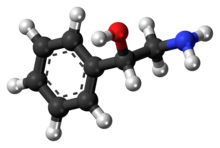
| |

| |
| Names | |
|---|---|
| IUPAC name
2-Amino-1-phenylethanol
| |
| Identifiers | |
3D model (JSmol)
|
|
| ChEBI | |
| ChEMBL | |
| ChemSpider | |
| ECHA InfoCard | 100.028.609 |
| KEGG | |
PubChem CID
|
|
| UNII | |
CompTox Dashboard (EPA)
|
|
| |
| |
| Properties | |
| C8H11NO | |
| Molar mass | 137.18 g/mol |
| Appearance | pale yellow solid |
| Melting point | 56 to 57 °C (133 to 135 °F; 329 to 330 K) |
| Boiling point | 157 to 160 °C (315 to 320 °F; 430 to 433 K) at 17 mmHg |
| soluble | |
Except where otherwise noted, data are given for materials in their standard state (at 25 °C [77 °F], 100 kPa).
| |
Phenylethanolamine (sometimes abbreviated PEOH), or β-hydroxyphenethylamine, is a trace amine with a structure similar to those of other trace phenethylamines as well as the catecholamine neurotransmitters dopamine, norepinephrine, and epinephrine. As an organic compound, phenylethanolamine is a β-hydroxylated phenethylamine that is also structurally related to a number of synthetic drugs in the substituted phenethylamine class. In common with these compounds, phenylethanolamine has strong cardiovascular activity[1] and, under the name Apophedrin, has been used as a drug to produce topical vasoconstriction.[2]
In appearance, phenylethanolamine is a white solid.
Phenylethanolamine is perhaps best known in the field of bioscience as part of the enzyme name "phenylethanolamine N-methyl transferase", referring to an enzyme which is responsible for the conversion of norepinephrine into epinephrine, as well as other related transformations.[3]
- ^ W. H. Hartung (1945). "Beta-phenethylamine derivatives." Ind. Eng. Chem. 37 126–136.
- ^ The Merck Index, 10th Ed. (1983), p. 1051, Merck & Co., Rahway.
- ^ J. Axelrod (1966). "Methylation reactions in the formation and metabolism of catecholamines and other biogenic amines. Pharmacol. Rev. 18 95–113.